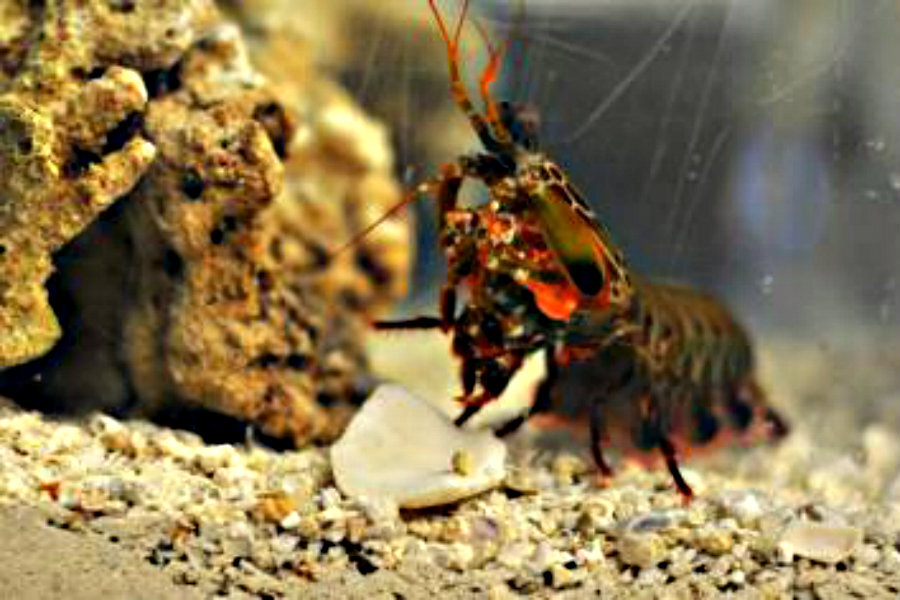Tiny shrimp's powerful punch inspires a new kind of human helmet
Loading...
The mantis shrimp has gained notoriety in recent years after being featured on popular internet sites such as YouTube or the webcomic, "The Oatmeal." This week, however, scientists have released a study that suggests the mantis shrimp may soon become better known for the body armor – including a helmet – it inspires.
Although researchers at University of California, Riverside, Purdue University, and other research institutions first began discussing the design implications of the mantis shrimp's club structure several years ago, the study published this week in the journal Advanced Materials examines the unique herringbone structure in the outer layer of the mantis shrimp's famous punching club.
Despite its petite size (measuring no more than six inches from head to tail), the little creature is best known for its phenomenal strength. Mantis shrimp use little hammer-like claws called dactyl clubs to deliver blows that can shatter aquarium glass.
The unusual strength displayed by the mantis shrimp has attracted researchers who are interested in replicating the remarkably strong material in the shrimp's dactyl club.
Scientists and engineers have been interested in the mantis shrimp's natural engineering for some time. In 2012, researchers published a paper about the internal structure of the dactyl club. Just two years later, some of those same researchers published further research about the club's structure and its applicability to material design.
In 2014, researchers suggested that the club's spiral architecture could inform innovation in protective materials engineering.
"The more we learn about this tiny creature and its multi-layered structural designs," co-author and UC Riverside professor David Kisailus said in a statement, "the more we realize how much it can help us as we design better planes, cars, sports equipment and armor."
A dactyl club can sail through water like a speeding bullet: a .22 caliber bullet, in fact, making it "one of the fastest and most powerful impacting events observed in nature," according to the authors. The little limb is separated into several parts, each of which contribute to the club's singular power.
The interior part of the club is called the periodic region. This region functions as the club's shock absorber, with two sections: an organic inner region and an outer, more mineralized one.
The organic section, shaped like a spiral staircase, is made of chitin, a familiar material for those who study the shells of organic creatures such as shrimp and insects. Its less organic section is composed of calcium phosphate and calcium carbonate. Together, these sections work together to disperse the shock of impact.
The team's most recent discovery applies to the club's outer "impact" layer, co-author and Purdue University professor Pablo Zavattieri tells The Christian Science Monitor in a phone interview.
This impact region has a unique herringbone structure, they found. "This time," says Dr. Zavattieri, "we found that the material of the club follows a sinusoidal shape. This is unique. We have studied other animals and we have only ever seen this shape in the mantis shrimp."
Sinusoidal shapes are those that follow a sine curve or sine wave.
The spiraling herringbone structure is crack resistant, and composed of both chitin and calcium phosphate.
"We knew from previous studies that the impact region allows the mantis shrimp to transfer incredible momentum to its prey while resisting fracture," co-author Nicholas Yaraghi, a doctoral candidate at UC Riverside, says in a press release, "but it was exciting to reveal through our research that the properties of this highly impact-resistant material are created by the novel herringbone structure."
Scientists have already 3D printed a helmet with a design inspired by the interior periodic region of the shrimp's dactyl club and an exterior designed with the dactyl club's exterior impact region in mind. The herringbone findings, funded in part by the US Air Force, may launch similar creations.
By using those 3D techniques, "we can actually take what we've learned about the architecture of the dactyl club and manufacture new composites with traditional engineering materials like polymer and carbon fiber," Kisailus said.
He has already put the group's research to work through his start up, Nature Inspired Industries.
Similar research into nature-inspired technology has produced a number of new materials, such as ceramics. Zavattieri told the Monitor that he expects to see technology inspired by the shrimp's unique herringbone club structure developed within the next five years.
"Now that we know about this new motif," he says, "people will start mimicking it in the near future."








